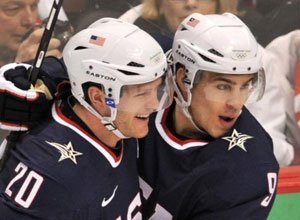
NHL Free Agency was, originally, to be a major component of the Brian Burke ‘rebuild’ model – or ‘retool,’ whatever you want to call it – when the Maple Leafs‘ new GM arrived in Toronto. And despite perpetual inflation, it remains the surest and easiest avenue for a team to obtain top-quality players in their prime without sacrificing any organizational assets beyond cash. Factoring in the promises of a quick turnaround and transactions we shall not name, lest we incite debate involving high-end draft picks exchanged for promising young stars, free agency to the Brian Burke model becomes…well, not quite a necessity…but a really, really valuable step in getting the Toronto Maple Leafs back to the Stanley Cup finals as efficiently as possible.
One can’t exactly say it’s worked out nicely, thus far.
The problem, as Burke’s lamented, has been the distinct lack of premier free agents available. Teams have compensated for the league’s attempts to “liberalize” the market by locking up their talented players before they become UFAs.
Moreover, the top tier free agents who’ve actually reached unrestricted status have brought with them their own issues. Far too often in Burke’s tenure, the debate has not been about whether Leafs can sign a particular star player, but whether or not they even should. Brad Richards’ red flags were advancing age, obvious-longterm-cap-circumvention contract demands, concussion history, and the likely-foregone conclusion he was always planning to sign in New York. With Ilya Kovalchuk, it was standard Russian xenophobia and questions of chemistry, character, and defensive reliability.
Using the last two summers as examples, you might expect the Leafs to be far more active signing secondary players to compliment the roster. They’ll consider Brandon Prust despite his supposedly ridiculous contract demands. They’ll hum and haw over whether or not Paul Gaustad is a good enough 3rd line centre to warrant the inflationary $3 million-ish/year he’ll command on the open market – assuming, of course, Nashville doesn’t reach a conclusion on the same question first. And hey, the Leafs might even let some incredibly valuable depth players who fit immediate team needs go to other organizations on slightly term-heavy, but majorly cap-friendly deals.
But this isn’t the last two summers.
What separates the 2012 free agent group from any other during Burke’s Toronto tenure is the quality of the crop’s headliners. That alone is, presumably, what the Leafs’ brass have been waiting to take advantage of.
Zach Parise is an elite offensive winger of exceptional character and work ethic. Tremendous speed, skill, and leadership qualities. He’s American, offering a Burke a familiarity with the player thanks to having selected him for international competition which – ending aside – went fairly well. He’s an improvement over any current Leaf left winger, better than most NHL left wingers, and probably the best left winger we can expect will be available via free agency anytime soon.
Ryan Suter is an all-around defenceman having benefited from years playing for one of the NHL’s best defensive teams. He puts up impressive offensive totals and would represent a vastly needed #2 punch on Toronto’s defensive squad to take the pressure off Dion Phaneuf of carrying the leadership load alone. Suter’s uniquely prepared for the role, perhaps, given that he’s played multiple seasons alongside a Phaneuf-type in Shea Weber. And unofficially (by which I mean I have no actual clue, but people have told me), Suter’s a close friend of Phil Kessel’s.
Now, these players aren’t without risk. There are minor concerns related to Zach Parise’s previous knee injury, and questions of who he displaces in the lineup should he sign. Does he steal Lupul”s preexisting Kessel chemistry and bump Joffrey to the second line? Does the Leafs’ acquisition of JVR via trade not suggest they don’t foresee adding a Top-6 LW body? Are they prepared to start that player – one they paid a steep price for in Luke Schenn – on the third line?
And potential defense pairings will be a factor in Suter’s signing of a massive contract with a new team. As fans, we have no way of knowing what the personal relationships between these players are really like – but it’s ignorant to assume they don’t play a part in these decisions. Rumors abound recently of Phaneuf’s personality clashes with multiple players, both in and outside Toronto. What if Ryan Suter simply doesn’t want to commit to multiple years playing alongside the Leafs’ captain?
Every championship team needs a core of elite players, and there are only three ways to acquire them: draft, trade, and free agency. Drafting requires patience and significant luck, and trading requires a depletion of existing assets. When it comes to obtaining these necessary assets, free agency is the fastest and ultimately lowest-risk way of adding core components to a team.
Two things tend to happen with free agency. An organization can acquire elite players at expectantly elite salaries, or mediocre players at inflated ones. The latter group is one that can be grown in-house at a fraction of the cost, hence the downside to signing external deals of the Colby Armstrong and Tim Connolly-ilk to fill positional or secondary needs. “Temporary bandages on permanent wounds,” to borrow a phrase from Mad Men’s Pete Campbell…despite the contexts being completely unrelated.
Availability has been Brian Burke’s greatest opponent when it comes to top-tier free agent signings in Toronto. From my point of view, Burke’s failure to impactfully (that’s not a word, which surprises me) improve the squad via this method has been legitimately excusable for the last three years on those grounds.
2012’s different.
Parise and Suter represent two age-appropriate, elite players that will cost the organization nothing more than money – the one asset MLSE has in glorious abundance. They are, during Brian Burke’s tenure, the first two top-tier players available on the July 1st market without any glaring, negative risk attached to a potential signing. And, they both have professional connections to the GM in question, a relationship in a business of relationships that should absolutely be mined for all it’s worth.
I wouldn’t dare go as far as saying that Burke failing to sign at least one of these two might be considered a failure: there are just too many factors beyond his control in the process to hamstring a GM with an evaluation like that. I can’t sit here and say, “Burke needs to add one of these players, or he’s done a bad job.”
The metric here is not the result. It’s the effort. And there is not one good reason that the Toronto Maple Leafs shouldn’t put the best offers on the table for both of these players – or, at the very least, the one target they consider to be of greater need.
You can’t control the player’s decision, but you can control where you rank amongst their options.
If MLSE wants to issue fans an apology that actually means something, it will come in the form of backing Burke with every available organizational asset during these negotiations. Whatever these players end up electing to do, the Leafs’ offers need to be ones that are outright tough to ignore – and when it comes to the conversation, Toronto has zero excuse not to be there.
At least, that’s what I’ll believe until Parise signs an eleventh-hour extension with New Jersey on Saturday night.


![Sheldon Keefe Post Game, Leafs 3 vs. Bruins 2: “I loved [the Matthews] line, and I loved a lot about our game all the way through the lineup” Sheldon Keefe, Toronto Maple Leafs post game](https://mapleleafshotstove.com/wp-content/uploads/2024/04/keefe-pg-game-1-218x150.jpg)


![Jim Montgomery on adjustments for Game 2 vs. the Maple Leafs: “We need to spend more time in the offensive zone… We didn’t do a good job offensively at five-on-five [in Game 1]” Jim Montgomery, Boston Bruins practice](https://mapleleafshotstove.com/wp-content/uploads/2024/04/jim-montgomery-bruins-218x150.jpg)





















![Sheldon Keefe Post Game, Leafs 3 vs. Bruins 2: “I loved [the Matthews] line, and I loved a lot about our game all the way through the lineup” Sheldon Keefe, Toronto Maple Leafs post game](https://mapleleafshotstove.com/wp-content/uploads/2024/04/keefe-pg-game-1-100x70.jpg)




![Jim Montgomery on adjustments for Game 2 vs. the Maple Leafs: “We need to spend more time in the offensive zone… We didn’t do a good job offensively at five-on-five [in Game 1]” Jim Montgomery, Boston Bruins practice](https://mapleleafshotstove.com/wp-content/uploads/2024/04/jim-montgomery-bruins-100x70.jpg)


